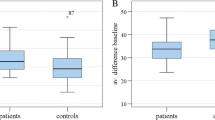Abstract
· Purpose: The topical carbonic anhydrase inhibitor dorzolamide has proven effective in lowering intraocular pressure in glaucoma patients. Because an impaired blood supply of the optic nerve has to be regarded as a major pathogenic risk factor it seems important to examine the effect of this new antiglaucomatous drug on capillary optic nerve head blood flow. · Methods: In a double-masked, randomized clinical trial, dorzolamide eye drops were applied to both eyes of 15 healthy subjects (8 female, 7 male, mean age 30.6 years) three times daily for 3 days. The control group (15 healthy volunteers, 9 female, 6 male, mean age 30.8 years) received a placebo preparation according to the same protocol. Intraocular pressure (IOP), blood pressure, heart rate, capillary optic nerve head blood flow and retinal blood flow were measured at baseline (1D0), 90 min after single instillation (1D90), and after 3 days of therapy (3D). Scanning laser Doppler flowmetry (Heidelberg Retina Flowmeter) and laser Doppler flowmetry according to Riva (Oculix 4000) were used to measure optic nerve head blood flow. · Results: IOP dropped in dorzolamide-treated subjects from 12.5 mmHg to 11.0/10.5 mmHg (1D0, 1D90, 3DO) and in the control group from 13.0 mmHg to 12.5/12.5 mmHg. Optic nerve blood flow as measured by scanning laser Doppler flowmetry showed no significant changes in dorzolamide-treated volunteers (temporal 310/329/315 AU, nasal 387/402/399 AU) or in the placebo group (temporal 238/306/276 AU, nasal 356/382/379 AU). Also as measured by laser Doppler flowmetry optic nerve head blood flow did not show significant changes in dorzolamide-treated volunteers (temporal 12.98/12.6/11.7 AU, nasal 16.6/16.9/15.7 AU) or in the placebo group (temporal 11.9/12.4/12.4 AU, nasal 16.1/15.8/17.7 AU). The systemic parameters blood pressure and heart rate remained unchanged during the treatment period. · Conclusion: The results showed the expected drop in IOP. However, capillary optic nerve head blood flow, measured by two different techniques, did not change during therapy. This may be due to the effective autoregulation in human optic nerve head circulation, which seems not to be affected by dorzolamide.
Similar content being viewed by others
Author information
Authors and Affiliations
Additional information
Received: 16 February 1998 Revised version received: 9 September 1998 Accepted: 12 October 1998
Rights and permissions
About this article
Cite this article
Pillunat, L., Böhm, A., Köller, A. et al. Effect of topical dorzolamide on optic nerve head blood flow. Graefe's Arch Clin Exp Ophthalmol 237, 495–500 (1999). https://doi.org/10.1007/s004170050268
Issue Date:
DOI: https://doi.org/10.1007/s004170050268




